I’m back in Portland, Oregon, from my six-week Nevada sojourn. But I haven’t unpacked my big linen canvases yet. I am almost afraid to do so, fearing that they are completely banal, hence total failures (banality is worse for me than bad).
In part, this reluctance has to do with various coming home challenges — burst pipes, unreliable contractors, relatives using the house in unexpected and unnerving ways. But in part, it’s simply because I don’t know what I did, although I am fairly certain I did not manage to un-orient, and my feeble attempts merely feel like they may be so feeble as to look feeble-minded.
Well, you see where I am. I began last February and March, 2009, living with the desert and Beatty, Nevada, painting small masonite panels, getting to know the territory and its inhabitants. This November sojourn, however, was more limited and almost entirely devoted to the Amargosa, which became more and more fascinating as I spent 6-8 hours a day, alone with the scene, for the full month of November.
So here are photos of the seven panels, plus the full panorama. These were taken as the panels were still on the wall of the Red Barn, under under limited lighting conditions. The exception is the full panorama, which was lit andphotographed by professional photographer, David Lancaster.
I am showing these in part to bolster my own sense of dignity and/or bravado.
 Unoriented Amargosa (panel 1, east), 4′ x 5′, oil on linen, 2009
Unoriented Amargosa (panel 1, east), 4′ x 5′, oil on linen, 2009
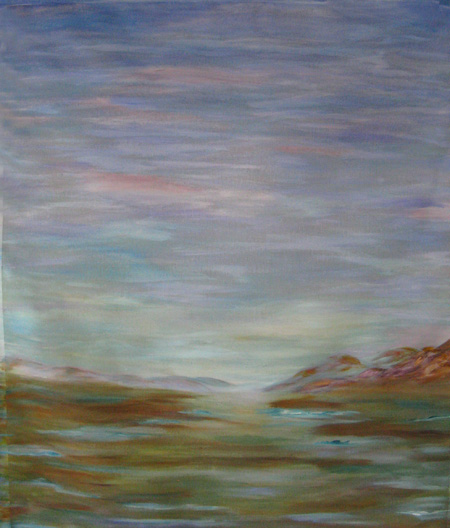 Unoriented Amargosa (panel 2, east), 4′ x 5′, oil on linen, 2009
Unoriented Amargosa (panel 2, east), 4′ x 5′, oil on linen, 2009
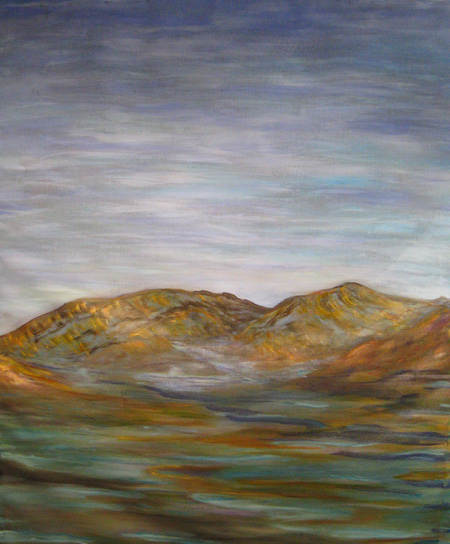 Unoriented Amargosa (panel 3, east), 4′ x 5′, oil on linen, 2009
Unoriented Amargosa (panel 3, east), 4′ x 5′, oil on linen, 2009
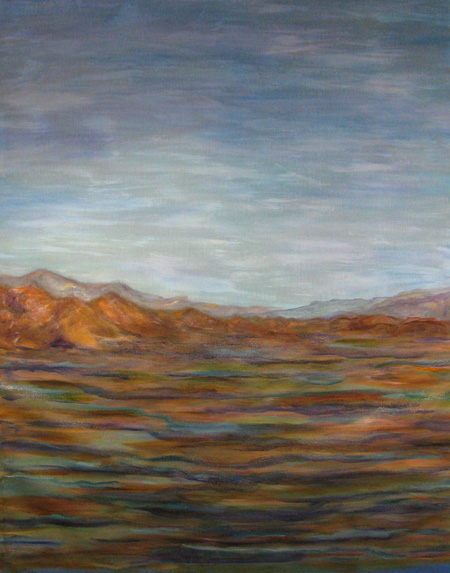 Unoriented Amargosa (panel 4, central), 4′ x 5′, oil on linen, 2009
Unoriented Amargosa (panel 4, central), 4′ x 5′, oil on linen, 2009
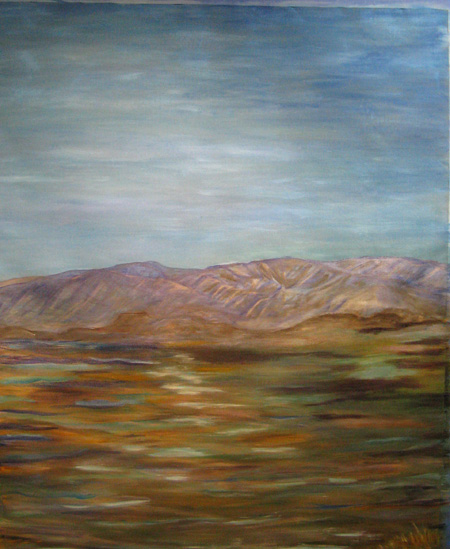 Unoriented Amargosa (panel 5, west), 4′ x 5′, oil on linen, 2009
Unoriented Amargosa (panel 5, west), 4′ x 5′, oil on linen, 2009
 Unoriented Amargosa (panel 6, west), 4′ x 5′, oil on linen, 2009
Unoriented Amargosa (panel 6, west), 4′ x 5′, oil on linen, 2009
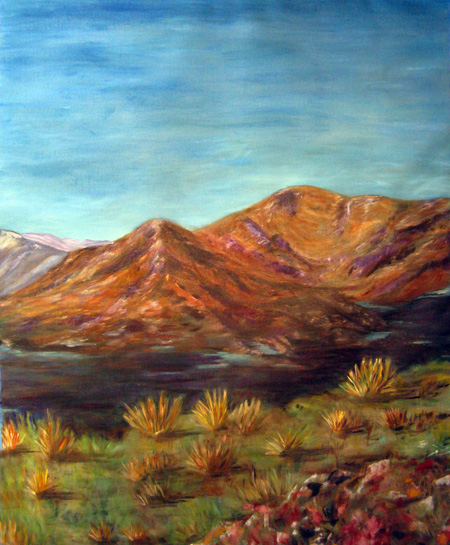 Unoriented Amargosa (panel 7,west), 4′ x 5′, oil on linen, 2009
Unoriented Amargosa (panel 7,west), 4′ x 5′, oil on linen, 2009
Let me assure you that I’m not looking for compliments. Sympathy maybe, but not false reassurances <snort>
What I will be working out this winter, I believe, is the nature of the horizontal. How much of it can be conveyed, how much of it needs color to work, what scale makes the power and fearful nature of the horizontal apparent? What media can be both intriguing and yet horizontal? How do verticals interrupt the horizontal and are they the only way to convey a sense of space?The problems of scale, color, and vertical interruptions are predominate in my mind as I try sussing out where I need to start.
You see, I’m already to start a new set of propositions, without having the courage to deal with the old. But only out of the old could come the new, so it’s probably OK.
And just for laughs, I’m also including the photo that David Lancaster, the professional photographer on the Goldwell Open Air Museum Board, took of me. It was taken in the waning sun hours, and David had a strobe light that allowed him to photograph me from below, directly in front of the sun. The strobe filled the front space, so I wasn’t just a silhouette. I kept hoping something similar could be done with the mountains, which required an extraordinary amount of vigilance to catch some relief, some sense of form and shape on as they were mostly just silhouettes against the desert sky. It was also David Lancaster who photographed the whole of the panorama, pictured below:
 Unoriented Amargosa Panorama, 28′ x 5′, oil on linen, 2009 (photo by David Lancaster)
Unoriented Amargosa Panorama, 28′ x 5′, oil on linen, 2009 (photo by David Lancaster)
 JOU, December, 2009. Take that, Universe!
JOU, December, 2009. Take that, Universe!

June,
This is SO NOT banal. The panels individually have color vibrations that almost strike me as living energy. I would love to see the whole set up, as the overall photo is too small to have much impact.
Karen Lewis
Thanks, Karen,
Once I get some space cleared in the studio, I’m hoping to open the box and find a helper to get the unstretched canvases stapled on. Then, I will (hope, hope) be able to arrange them around the studio (which seemed big until I did these monsters) and have a “showing” for all in the area who have wondered what these really look like. I think they will do well as a semi-circular panorama; that might have been the point. Or one of them.
I’ll send out a notice to Portland Plein Air when I get to that point.
Know any savvy people able to stretch big paintings?
Thanks again for checking in.
You cast a long shadow June Underwood.
It’s a bold thing you’ve done and I think you took it as far as it would go. You accepted the challenge of capturing something important about the great voids of the desert plain and a sky that seems to diminish and fuddle the ground upon which it rests. Another painter might have dressed up the foreground with rocks and other desert debris, and while that may have made the panorama more topically interesting, it would have sidestepped the issue of all that space.
Hi Jay,
In truth, it was the strobe light that cast the long shadow. I also have a photo in which I have two shadows, one from the light behind and one from the light to the side. Both long! In fact, I’m rather fond of the contrary way this shadow defies the area from which the light is coming. And in a photograph, which never lies, of course.
And of course, you may be right — I may have taken the desert scene as far as I’m capable of. I want it (the painting set, I mean) to be somehow haunting and/or explosive, but this may be as far as I can go with it. But I’m thinking of Robert Irwin and his two-year stare at lines and so I keep noting horizontals. I was zipping through my travel and desert photos and realized that when I moved through them very quickly, the horizontals, sky and land, were phenomenal. A bit like one of the trick picture books, where you flip the pages fast to see the characters move. These lines moved, but all horizontally.
Thanks for checking in. I’m still pondering the desert debris, particularly as it is, in some large part, composed of mining and miners debris as well as off-road vehicle tracks that will last millenia. Whole ‘nother subject, I fear.
June,
The color interactions are fabulous. These paintings now remind me of your textiles that I love.
I don’t agree with Jay that this is as far as you can go. What a depressing thought to have achieved the ultimate.
I have not touched a brush for one month and won’t be able for another one.
Slaving away, day job, elder care.
To cheer myself up, I ordered a Rosetta Stone to learn Italian so that I can communicate with locals once I go there to enjoy the 4 Renaissance painting methods.
In my mind, I am shedding adult responsibilities to open to child-like wonder.
Birgit,
What a fascinating idea — learn Italian to better learn painting. What a gorgeous way to open up new possibilities.
I have no language abilities, no background to help me out, and what I was taught was almost entirely written — the old instructional method. My daughter is a Spanish professor and has three languages that she knows well and a couple of others plus Latin that she’s working on. I am in awe!
Thank you for the comments on the paintings. I still haven’t opened the box, but I have found someone to help me with the stretching of the painted canvases once I get the Studio cleaned out a bit more. I need to re-work the small panorama panels before I open up the kettle of worms that the big ones have come to represent to me.
I don’t think Jay meant that I had reached an ultimate; I think he was really just saying I had done the best I could with the material I had to work with –snort– I’m still thinking about those horizontals — how they mean, if you catch my meaning. They are the monolithic opposites of the cluttered vertical landscapes of the Pacific Northwest — even the Oregon coast has its verticals — rocks extruded into the water as well as cliffs that fall into the sea. And shape is a negligent factor in the desert. So color is the only wide variable to work on — and horizontals the biggest factor to deal with.
Although I doubt you could see it in the presentation above, I worked in some subtle “v” and inverted “v” shapes through the desert ground — about five of them. They aren’t clearly delineated, but I was hoping they would give some form to the formless horizontals. I’ll see when I open the boxes.
I think now I’ve made such a big thing about opening the boxes that I may have to buy champagne, just to get through the process (I’m grinning at that thought!)
Ah, just blithering, this December morning, almost soltice. Thanks for checking in. I’m glad you have the Italian to get you through some of the non-painting days.
Guys:
The point I think I was making is that, given format, subject, medium – and especially the subject – this is complete. Sure, you can be perhaps a little dissatisfied with the outcome, which is a commonplace reaction among artists, but I find it completely satisfying. This may sound a little out there but the scene puts me in mind of something coming into existence; as though the entire landscape is issuing from an egg. Some parts have dried and are delineated and crisp of outline, while others await.
Hi Jay, Thanks for the more complete observations. The “coming into existence” is really fascinating to me. The landscape panorama, done with the artist’s eye on the scene, is in fact sharper at the edges and fuzzier in the middle because in the middle, the distances of the scene are much greater (40 miles vesus one mile). The distances in the middle of the desert (not of course the “middle distance” as it is used in art conversations) have an indefinable sense of space — too far to get a handle on, somewhat ambiguous. Maybe you can drive there; maybe not. Maybe you can see the mountain crevices; maybe not.
This was not nearly so true in the Oregon “high desert” where the spaces are less spacious, less “slippery” of definition.
I am always surprised (again and again) at the way things in the desert almost seem walkable — and then turn out to be inexorably beyond reach. And when you are watching over days and days, different parts seem able to be reached, until you try, and then realize you can’t even make it to the first landmark you saw from your starting place.
There’s a landmark cemetery, 1/2 mile I am told, from where I was working. I could see it clearly — a marker stands up against the desert horizontals (one of the few verticals besides derelict telephone poles). But I never could get to it on foot. I can walk half a mile, but I think that that cemetery (the Bullfrog, if you need a name, having Panamint Annie’s grave in it) is somehow further, with ravines and cactus, heaps of glass and shards of rusting metal, holes where houses — or mining attempts — all exist out of sight. They linger forever, hindering the footbound traveler.
I spent 12 weeks looking at the Bullfrog cemetary and watching cars drive down the desert track to it. I drove to it several times with Jer and friends. I tried to walk to it. But I never could get there on foot. Disoriented or un-oriented — it was visible when I started but got subsumed by the Amargosa, which hoarded it beyond my reach.
Well, you see, in wet Portland I wax verbal. It occurs to me that in wet western Oregon, all the conditions are the opposite of the Nevada desert — forms within the scenes are cluttered and have to be simplified; verticality reigns — vertical trees, mountains, clouds. It could drive the landscape artist mad, if she weren’t already there.
Thanks for commenting. And thanks for the “completely satisfying.” I value your eye.
And you can google Panamint Annie, who was one gutsy, if also tipsy, person.
Birgit:
I too have little facility with languages. Sounds like a grand adventure. Enjoy and report upon your return.
June:
Yes, it reminds me of astronomical distances that are measured in the time it takes for light to go from point a to b. Those mountains that punctuate the horizon are obviously not light years distant, but their remove from any context upon which one might lay a hand feels out of time – as though atavistic things may be going on out there. But the effect can be reciprocal; the old prospector mumbling to his weary mule looks back across the plain and wonders. The desert is just the place for aliens, hoodoos and things that go remotely bump in the night.
Hi June … Audrey here, of the Diamond ’09 clan. Firstly, my admiration for you toughing it out 6-8 hours a day in November. That deserves an en plein air medal!!! You and the desert must have had the same pulse, breath. I’m truly impressed. As for being finished, my opinion is you’ve only begun. I can see the next step as simplifying further. Reducing evidence of strokes and somehow capturing all of that oneness with all of that atmosphere and earth. Maybe blending the two. I don’t know, but I’d hate to see you wrap it up when I see so much more potential. You’re on a roll, girl. And that picture! You look in control of all of that uncontrol-able landscape! I love it.
Hey Audrey-of-the-Diamond ’09 clan — great to hear from you!
About that “toughing” it out — all in the Interests of Art, of course, (and bragging a bit, too, –snort–). In actual fact, the time out there was essential; for me it was the only way to begin the process of comprehending that scene properly. Anti-snapshot, if you will.
Thanks for your comments: I’m still pondering on where I go from here. I began last night working on the small panorama of the same scene on masonite. I wasn’t happy with it, but thought of it as a study for the larger work. Now I am intent upon turning it into a set of paintings in their own right. This work, of course, takes me back to the desert in my head. I may have to do another set of studies, not working with anything but what I wish I had done and the memory of what I did.
The one problem I see with simplification is that that’s what has been done in the past: the Maynard Dixon I showed a couple of posts ago is a case in point. Simplification, in my head, lends itself to a sense of a single moment — the photo-shot rather than the drum of time that those hours consisted of. I may be totally off base here (I’m a master at making the words fit my self-deceptions), so I’m aware that I may change my mind at any moment.
I’ve still not opened the box of canvases — but they are starting to tug at me. I think the time is coming when I will have to look at them again, with fresh eyes and in good light.
Thanks, too, Audry, for the comment about the photo. Definitely better than the mug-shot-in-front-of-the-canvas, when the photographer was trying to make me look official.
By the way, Patty Gifford, of our Diamond adventures has also been in touch. She’s coming over after Christmas to check in on the final Diamond panorama, which now graces my textile studio wall (the only one big enough to hold the whole thing). I’ll tell her you also checked in.
Jay,
Interestingly enough, one of the Beatty desert rats, a gentleman named John, gifted me a 13 x 19 superbly printed photo from a Hubble view of the Milky Way. It’s stunning; more than my mind can get around. But your observation of “light years” makes me thing of my “light hours” — that what we see has already gone past and happened long ago. Or some such nonsense. Out of context, for sure, and yet, and yet — I was there! Although the hours all blend together and the context was always the same, while the scene always different. Yow!
Wow. I disappear for six months and look what you do. Looking back, I can see the relation to your earlier paintings of the Amargosa, where you were especially concerned with the void. But now the playa has really become an ocean, as big as the ocean of sky from which it is separated by the ranges on the horizon. The mountains appear more clearly defined, but those apparent details are actually huge land features at a great distance. There is closer detail only at the edges of the panorama, where it wraps around back to the observer. Curiously, the more mysterious parts are not those cloaked in atmospheric shimmer, but the sharper mountains, too far to reach.
Hey Steve, how good to hear from you!
I found your comment — “the more mysterious parts are not those cloaked in atmospheric shimmer, but the sharper mountains, too far to reach” — to be right on the mark with my experience. Trying to get a handle on those far mountains was maddening — er — challenging. The day I saw the Long Slope (Panel # 5, I believe) with some forms inside its silhouette was singular; I never caught it again after that. The shimmer we all think we know — atmospheric perspective and all that. But those silhouetted mountains are almost unknowable.
It will be interesting to see what happens when I stretch the canvases and set them up in a semi-circle around my home studio — I think the experience will be vastly different from having them stretched along the long wall of the big barn where I painted them. I hope it isn’t claustrophobic.
Thanks for checking in, Steve. Are you still photographing and thinking about color and abstracts?
June,
No, I haven’t been photographing, either, more’s the pity. But I expect to get back to that soon, as well. Not to mention prepare the tree show for an April-May run. Color and perception have, however, come into play in the major web site design I’ve been totally preoccupied with. I may find time to post on that before too long, though most of the effort, even the design part of it, is not really art.
Glad to hear you are having that tree show. Let us know how it goes. And definitely tell us about the major web site design. Mine needs a new design, but alas, I’m not the one to do it. I keep looking for elegant ways so when I get the cash, I’ll have the concept.
Steve;
What a holiday gift! It was like a hole in the web with you gone for those six months – now rewoven with your return.
The best to you and yours this season.
Hi June,
I won’t waste a lot of superlatives here. The work is simply wonderful.
Hi June,
“What I will be working out this winter, I believe, is the nature of the horizontal.”
I think this is a beautiful sentence. Ripe for the beginning of a poem.
Cheers,
Erin
Or for the title of an exhibit of your work. That may be more apt. :)
Thanks Tree and Erin, I’ve been away from A&P too long and you have brought me back. Tree, I saw your comment on my email and then lost it — couldn’t even remember where you had commented — that’s the state I’ve been in. And Erin, maybe a poem and an exhibit. I actually, in a former life, published two poems. This doesn’t put me into any history books, but it’s fun to remember. I’m a better painter than poet, though.
I will get back into stride soon and try to be a more faithful reader, writer, thinker.